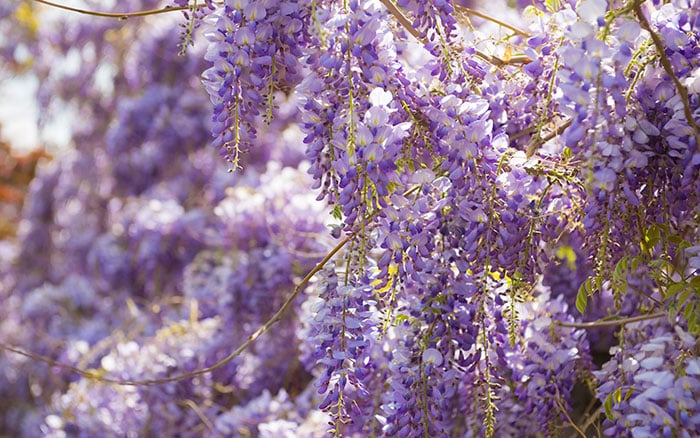One of nature’s spring garden masterpieces is the sight of cascading flowers from a wisteria. Although wisteria is synonymous with country cottage gardens, the two most popular cultivars of this stunning plant hail from Japan (Wisteria floribunda) and China (Wisteria sinensis), both introduced to the U.K. in the early 1800’s. Find out how to care for your climber in this guide to pruning young wisteria.
All about wisteria
Wisteria are vigorous woody climbers, many with beautiful, highly scented, pea-like flowers. They look magnificent trained against walls, covering fences, pergolas and balconies, or growing up and amongst the branches of tall trees. The pea-like flowers hang in pendulous strands and can be found in shades of lavender, purple, pink or white.
An easy way to tell if you have either W. sinensis or W. floribunda is to see which direction the stems are twining. If they’re growing in an anti-clockwise direction it’s sinensis if it’s growing in a clockwise direction then it’s floribunda.
They love full sun and normally flower between May and June.
They can however, be daunting as their rate of growth in the summer can be alarmingly great. They are capable of reaching heights of six metres within a couple of years, but the good news is they can easily be kept under control by just pruning them twice a year.

Training young wisteria
If you have a young wisteria plant this will need training in its early years to establish a good framework of branches to best display the flowers.
To do this firstly choose what will become the main stem of the plant, known as the ‘leader’.
Then prune away all the low branches, cutting them back as close as possible to the main stem.
Look at the remaining side stems, pick the strongest looking ones and tie them loosely in to your framework, whether that be fence, wall or pergola, using strong twine, never metal ties as they can cut into the stems stopping growth.

Pruning young wisteria plants
Wisteria are pruned twice a year, no matter what the age of the plant, once in the summer, July or August and again in the winter either January or February.
The aim of the summer pruning is to cut back all long stem growth that suddenly occurs at that time of year after flowering has finished.
It’s a very straightforward process but is important to do to stop the vine romping away and becoming tall and overgrown. Simply cut all stems leaving just 5 sets of leaves on each stem counting back along the stem from the main leader.
The winter pruning is again straightforward. Cut back those same stems closer towards the main stem leaving 2 or 3 leaf buds on each stem. Doing this not only keeps the plant neat and tidy but, more importantly, cutting back that close to the main stems triggers the vine to create new flowers rather than leaves for the following spring.
January or February is also the best time to cut back the height of the leader to the best height you’d like the vine to be.

Upkeep and care
In summer, once flowering is done, the green growth of the wisteria from the current year can be cut back, leaving five or six leaves per branch. Not only will this keep it looking good and controlled, but once again it will encourage more flowering buds rather than leaf buds.
Whilst the wisteria is young, prune like this every year, helping to guide the main vine, or two. At these times, also keep an eye on the base of the plant and remove any more shoots coming from the base.

With this guide to pruning and training young wisteria, you can have a cascading climber of blooms that brings colour and fragrance to your garden through the year. From young plants to mature ones, putting in the right care at the start will make it worth the wait for the elegant flower show.
For more great gardening advice, make sure you head to my YouTube Channel. Make sure you’re subscribed with notifications on so you don’t miss any of my new videos
Frequently Asked Questions
1 – Why does wisteria need pruning twice a year?
Wisteria grows rapidly and can become unruly. Summer pruning controls size and shape, while winter pruning encourages flower production by reducing excess leafy growth. Both are essential to keeping your climber flowering beautifully each spring.
2 – How do I prune wisteria in summer?
In July or August, cut back all long, whippy shoots to five leaflets from the main stem. This prevents the vine from becoming too tall or tangled and helps direct the plant’s energy towards developing flower buds.
3 – What’s the winter wisteria pruning method?
During January or February, cut those same summer-pruned stems back to 2 or 3 buds from the base. This close cut promotes flower bud formation for spring rather than excess leafy growth.
4 – What support is best for training wisteria?
Use strong structures like walls, pergolas, or fences. Ensure supports are sturdy and able to handle the weight of mature stems. Always tie stems loosely with twine—never with metal ties, which can cut into the wood and inhibit growth.
5 – Will pruning my wisteria encourage more flowers?
Yes! Regular pruning is key to flower production. Cutting back side shoots in winter to just a couple of buds helps shift the plant’s energy from foliage into flower formation. This results in a more spectacular display the following spring.

Leave A Comment